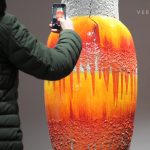For the exhibition Last Supper, the collector and director of the gallery Salon Dahlmann in Berlin, Timo Miettinen, invited two artists: Marianna Uutinen and Anselm Reyle. Berlin-based artist Anselm Reyle is best known for his abstract and high gloss foil paintings and found object works, Finnish painter Marianna Uutinen’s acrylic paintings play with kitsch and charm. The joint exhibition, which is curated by Reyle and Uutinen themselves, shows the many elements both artist have in common whilst working across a wide spectrum of media and materials: reliefs, crushed foil structures, clashes of color, pieces of furniture and various objects stemming from the Eighties until today. The commonality goes so far that the viewers often do not know which of the two artists has created a particular work.
In this video we attend the opening reception of the exhibition, and Timo Miettinen, (collector and director of the Salon Dahlmann) provides us with an introduction to the space and exhibition. Marianna Uutinen speaks about the significance of Anselm Reyle’s works. Finally, Anselm Reyle talks in detail about the work of Marianna Uutinen, the concept of the show and how this collaboration came about. The show runs until January 25, 2014.
Anselm Reyle (b. 1970) is one of the leading German artist based in Berlin. He is known for his large-scale abstract paintings and found-object sculptures. He is now represented by Almine Rech in Brussels and Paris, Gagosian in the US and Andersens Contemporary in Copenhagen.
Marianna Uutinen (b. 1961) is one of the leading names in contemporary Finnish art. Uutinen lives and works in Berlin and Helsinki. Uutinen’s work is represented in the collections of the Helsinki Art Museum, Kiasma and EMMA, The Modern Museum in Stockholm, the Museum of Contemporary Art in Oslo and the Seoul Museum of Art and also in a number of private collections.
Anselm Reyle & Marianna Uutinen: Last Supper at the Salon Dahlmann, Berlin (Germany), November 9, 2013. Video by Frantisek Zachoval.
> Right-click (Mac: ctrl-click) this link to download Quicktime video file.
From the press release:
Under the banner “Last Supper”, Salon Dahlmann presents the first joint exhibition of Finnish artist Marianna Uutinen und Berlin-based painter Anselm Reyle on the 9th of November 2013. Just like Pop-Art icon Andy Warhol’s final cycle of art works, which was also titled “Last Supper”, this show – curated by Reyle and Uutinen themselves – is not only dedicated to superficiality, illusion and temptation; attracting and repelling the viewer in equal measure.
The dimensions of this cooperation are expounded upon in this exhibition, which shows the many elements both artist have in common whilst working across a surprisingly wide spectrum: reliefs, crushed foil structures, clashes of color, pieces of furniture and various objects stemming from the Eighties until today. Uutinen and Reyle’s works are based on various art historical movements but are also dealing with current themes, juxtaposing consumer culture with the history of art.
There are echoes of the formal vocabulary of Hard Edge, Minimal Art and links with Abstract Expressionism in both two-dimensional works as well as objects. The works dealwith the processes of artistic production and questions of authorship. Through the juxtaposition of Uutinen and Reyle’s work, a new context is created regarding for a discussion with and about the medium of painting: how can painting still compete with our multi-media dominated reality, and what are its limits?
For the first time, the early influence of Marianna Uutinen’s art on Anselm Reyle’s work is explored. Meanwhile, it also becomes apparent that Uutinen has incorporated Reyle’s oeuvre as well. Reyle first saw Uutinen’s art as early as 1995, when he was still an art student at the academy in Karlsruhe, he visited her exhibition at the Stuttgart Kunstverein. Her clear, minimalistic form language and unexpected use of materials – as in “Untitled”, 1989 – left an indelible impression on him. Her works continue to inform his artistic formal language as well as his radical use of material objects and inquiries into the meaning of art. His work is driven by the almost cringe-worthy banality of his motifs, as in his stripe paintings and painting-by-numbers pieces, as well as his appropriation of the residues of urban life such as footstools, vases and seemingly cheap shiny silver foil. He steers all these elements towards a brutal confrontation, critically cross-examining the idea of so-called “low art” and “high art”.
Marianna Uutinen’s work is similarly multi-faceted. She explores the various artistic levels of “camp” by taking it to a nearly excruciating level with tacky colors and plasticky materials. As early as 1964, theorist Susan Sonntag explained in her essay “Notes on Camp,” how this dimension of Kitsch can weave a web of meanings as well as constitute a play with symbols, challenging conventional approaches to perception. In the same manner, Uutinen provokes the viewer with the illusory materiality of her works. Although they appear to consist of scrunched-up pieces of silver foil, they are actually made up of numerous layers of paint. Through her surprising application of painting techniques, Uutinen’s art converges with Reyle’s work, who also explores the medium of painting through his nearly musical, swinging dynamics of color interspersed with jarring dissonances. In this manner, they abandon the medium’s hierarchical structures and expand its possibilities.





